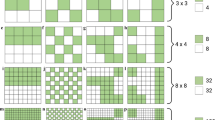Abstract
In the landscape ecological literature, a number of measures have been proposed for quantifying landscape fragmentation based on distinct objectives and motivations. However, none seems to be generally preferred. The main reason for this disagreement is that, from a statistical viewpoint, by mapping fragmentation into a single scalar, information is necessarily lost and no ideal function is able to uniquely characterize all aspects of landscape fragmentation. A more complete summarization of fragmentation is possible if, instead of one single index, a parametric index family is applied whose members have varying sensitivities to the presence of large and small landscape patches. While traditional indices supply point descriptions of fragmentation, according to a parametric fragmentation family H α, there is a continuum of possible fragmentation measures that differ in their sensitivity to the presence of large and small patches as a function of the scaling parameter α. Therefore, changing α allows for vector description of fragmentation. The purpose of this paper is to introduce a parametric generalization of Shannon’s entropy to summarize landscape fragmentation. A small set of artificial landscapes is used to clarify our proposal.


Similar content being viewed by others
References
Burkey TV (1999) Extinction in fragmented habitats predicted from stochastic birth-death processes with density dependence. J Theor Biol 199:395–406
Corona P, Marchetti M (2000) Towards an effective integration of forest inventories and natural resources surveys: the Italian perspective. In: Hansen M, Burk T (eds) Integrated tools for natural resources inventories in the 21st century. USDA, Forest Service, North Central Reseach Station GTR, NC-212, pp 28–34
Crooks DR, Soulé ME (1999) Mesopredator release and avifaunal extinctions in a fragmented system. Nature 400:563–566
Forman RTT (1995) Landscape mosaics. Cambridge Univesity Press, Cambridge
Friedenburg LK (1997) Physical effects of habitat fragmentation. In: Fielder PL, Kareiva PM (eds) Conservation biology for the coming decade. Chapman and Hall, New York, pp 66–79
Frohn RC (1998) Remote sensing for landscape ecology. Lewis Publishers, Boca Raton
Gonzalez A, Lawton JH, Gilbert FS, Blackburn TM, Evans-Freke I (1998) Metapopulation dynamics, abundance and distribution in a microecosystem. Science 281:2045–2047
Hanski I (1998) Metapopulation dynamics. Nature 396:41–49
Hanski I, Ovaskainen O (2000) The metapopulation capacity of a fragmented landscape. Nature 404:755–758
Hill MO (1973) Diversity and evenness: a unifying notation and its consequences. Ecology 54:427–431
Kleinn C, Traub B (2003) Describing landscape pattern by sampling methods. In: Corona P, Köhl M, Marchetti M (eds) Advances in forest inventory for sustainable forest management and biodiversity monitoring. Kluwer, Dordrecht, pp 175–190
Köhl M (2003) New approaches for multiresource forest inventories. In: Corona P, Köhl M, Marchetti M (eds) Advances in forest inventory for sustainable forest management and biodiversity monitoring. Kluwer, Dordrecht, pp 1–16
Laurance WF, Ferreira LV, Rankin-de Merona JM, Laurance SG (1998) Rain forest fragmentation and the dynamics of Amazonian tree communities. Ecology 79:2032–2040
Li H, Reynolds JF (1993) A new contagion index to quantify spatial patterns of landscapes. Landsc Ecol 8:155–162
Lund HG (1998) IUFRO Guidelines for designing multipurpose resource inventories. IUFRO World Series, vol 8, Wien, Austria
MacGarigal K, Marks BJ (1995) FRAGSTATS: spatial pattern analysis program for quantifying landscape structure USDA Forest Service, Pacific Northwest Research Station, General technical report PNW-GTR-351. Portland, OR
O’Neill RV, Krummel JR, Gardner RH, Sugihara G, Jackson B, De Angelis DL, Milne BT, Turner MG, Zygmunt B, Christensen SW, Dale VH, Graham RL (1988) Indices of landscape pattern. Landsc Ecol 1:153–162
Olff H, Ritchie ME (2002) Fragmented nature: consequences for biodiversity. Landsc Urban Plan 58:83–92
Patil GP, Taillie C (1982) Diversity as a concept and its measurement. J Am Stat Ass 77:548–567
Pickett STA, White PS (1985) The ecology of natural disturbance and patch dynamics. Academic, New York
Podani J (1992) Space series analysis: processes reconsidered. Abstr Bot 16:25–29
Rényi A (1970) Probability theory. North Holland, Amsterdam
Riitters KH, O’Neill RV, Hunsaker CT, Wickham JD, Yankee DH, Timmins SP, Jones KB, Jackson BL (1995) A factor analysis of community pattern and structure metrics. Landsc Ecol 10:23–39
Ricotta C (2002) Measuring taxonomic diversity with parametric information functions. Commun Ecol 3:95–99
Ricotta C, Corona P, Marchetti M, Chirici G, Innamorati S (2003) lady: software for assessing local landscape diversity profiles of raster land cover maps using geographic windows. Environ Model Softw 18:373–378
Shannon C (1948) A mathematical theory of communication. Bell Syst Tech J 27:379–423
Simpson EH (1949) Measurement of diversity. Nature 163:688
Turner MG (1990) Spatial and temporal analysis of landscape patterns. Landsc Ecol 4:21–30
Weber MG, Flannigan MD (1997) Canadian boreal forest ecosystem structure and function in a changing climate: impact on fire regimes. Environ Rev 5:145–166
Author information
Authors and Affiliations
Corresponding author
Additional information
Communicated by Michel Köhl
Rights and permissions
About this article
Cite this article
Ricotta, C., Corona, P., Marchetti, M. et al. On parametric fragmentation measures. Eur J Forest Res 125, 441–444 (2006). https://doi.org/10.1007/s10342-006-0139-1
Received:
Accepted:
Published:
Issue Date:
DOI: https://doi.org/10.1007/s10342-006-0139-1




